Concerns Remain About Lithium-Ion Batteries
The ICAO will consider an FAA proposal to ban laptops in checked baggage on all international flights due to concerns about fires caused by lithium-ion batteries contained in the devices.

Gizmodo reports that the agency recently published a paper with results of testing that shows that when the batteries overheat, they can cause fires and explosions when packed with combustible materials like hairspray and dry shampoo. Such an explosion can put the entire aircraft at risk, depending on the aircraft, according to the report.
According to the FAA document included with an ICAO report, the FAA Fire Safety Branch has conducted 10 tests utilizing a fully charged laptop computer inside a suitcase. The suitcases varied in construction and in the density and types of items inside, as well as, the construction of the outer case. A heater was placed against a lithium ion cell in the battery of a laptop to force it into thermal runaway.
For the first five tests, the suitcases were filled with clothes, shoes, etc., but no other currently permitted dangerous goods. In four of those tests, the fire was contained and eventually self-extinguished, and the suitcases were not breached. In one test, conducted without the Halon fire suppression system, the resulting fire burned out of the suitcase and fully consumed it; in this test, the battery burned a hole in the suitcase, which may have allowed oxygen to enter to fuel the fire.
A test of this same scenario was also conducted with an eight-ounce aerosol can of dry shampoo strapped to the laptop battery and added to the suitcase contents. The dry shampoo is currently permitted to be carried in checked baggage. This test yielded the most troubling results. Fire was observed almost immediately after thermal runaway was initiated. The fire rapidly grew, and within 40 seconds, the aerosol can of shampoo exploded with the resulting fire rapidly consuming the bag and its contents. This test showed that, given the rapid progression of the fire, a Halon fire suppression system cannot dispense Halon quickly enough to reach a sufficient concentration to suppress the fire and prevent the explosion.
Four additional tests were conducted to further characterize the risk. In addition to the dry shampoo, a 6 oz. bottle of nail polish remover, 2 oz. bottle of hand sanitizer and a 16 oz. bottle of 70% ethyl rubbing alcohol were included. Three of those tests resulted in the can or bottle containing the dangerous goods bur sting leading to a large fire. In only one test was the fire contained within the case. As a result of this, it was concluded that if a PED is packed in a suitcase with an aerosol can and a thermal runaway event occurs, there is the potential for an aerosol can explosion. The explosion itself may or may not be strong enough to structurally damage the aircraft, but in a Class C cargo compartment it will most likely compromise the Halon fire suppression system by dislodging blow panels or cargo liners, rendering the compartment unable to contain the Halon. The fire suppression system of the aircraft is then compromised, which could lead to the loss of the aircraft.
The outcome of the testing indicates that large PEDs in checked baggage mixed with an aerosol can produce an explosion and fire that the aircraft cargo fire suppression system in Class C cargo compartments may not be able to safely manage. Globally, there are aircraft in the commer cial fleet that do not have the same level of cargo fire suppression in the cargo hold, which places passengers in greater jeopardy if a PED catches fire in checked baggage.
Additionally, even if individual operators voluntarily implemented policies to for bid the carriage of large PEDs in checked baggage, the risk associated with large PEDs in checked baggage could be transferred to their flights from the aircraft during interlining of passengers and baggage —and without the operators’ knowledge.
The FAA paper does not say whether the ban should also be extended to domestic flights. The agency sees this as a global issue that should be addressed by the U.N.
The ICAO will reportedly be discussing the issue during meetings this week. If it agrees with the FAA, any proposal would have to be adopted by each participating country individually.
(Image from FAA PowerPoint presentation from testing)
 ANN's Daily Aero-Linx (04.15.24)
ANN's Daily Aero-Linx (04.15.24) Classic Aero-TV: 'No Other Options' -- The Israeli Air Force's Danny Shapira
Classic Aero-TV: 'No Other Options' -- The Israeli Air Force's Danny Shapira Aero-News: Quote of the Day (04.15.24)
Aero-News: Quote of the Day (04.15.24) Airborne 04.16.24: RV Update, Affordable Flying Expo, Diamond Lil
Airborne 04.16.24: RV Update, Affordable Flying Expo, Diamond Lil ANN's Daily Aero-Term (04.16.24): Chart Supplement US
ANN's Daily Aero-Term (04.16.24): Chart Supplement US



